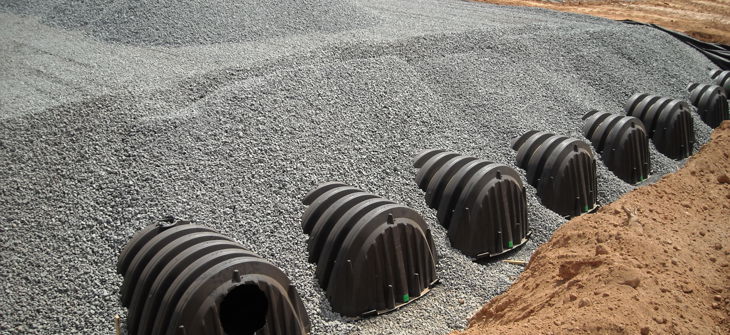
Are we Losing it? The Sediment, Associated Pollutants, and Infiltration Capacity that is.
Are We Protecting Our Infiltration Systems—or Just Burying the Problem?
We’re making a lot of progress in the field of stormwater management, and as ongoing research sheds light on the growing suite of things in runoff we ought to be concerned about, our thirst (no pun intended) for affordable solutions has never been greater. Infiltration is not a new concept, but its popularity as a first line of defense against harmful discharges to receiving waters, not to mention reducing excess runoff volume, is still expanding. On the surface, it’s a no-brainer: prevent the runoff from, well, running off, and you have just reduced the potential pollutant load by 100%. Not to mention reducing the potential for harmful streambank erosion in sensitive watersheds in the process. An amazing tool, really, where it’s feasible at least, and proper steps are taken to ensure systems remain operational, accessible, and maintainable over time.
I’ve uttered plenty about filters over the years; they work wonderfully for capturing pollutants right up until they clog, and they all do eventually clog, necessitating maintenance to restore their porosity and functionality. Infiltration systems are very much part of the filter family. We are relying on either an engineered soil/media layer and/or native soils to filter stormwater runoff as it makes its way into the groundwater. This method works rather well for retaining particulate matter in the upper media or soil layers, but over time, these layers are prone to clogging and will require maintenance to restore their functionality. Let’s face it, maintenance is still not our collective strong suit, so we really ought to be thinking strategically about how we design our stormwater control measures (SCMs) to give ourselves a fighting chance of making it happen at the lowest possible life cycle cost.
One trend that seems particularly short-sighted is our growing reliance on space-constrained, i.e., inaccessible by humans and standard maintenance equipment, underground infiltration systems without taking reasonable steps to effectively pretreat these practices to ensure they will remain functional for the long haul. For example, the use of geotextile-wrapped arched chamber rows to provide pretreatment ahead of a larger gallery of arched chambers infiltrating into native soils has become quite popular in some regions due to its relatively low cost. However, the data collected on this type of pretreatment practice tells a concerning story relative to sediment fate.
The effective opening size for the geotextile layers being used to filter particulate is often rather large in stormwater terms, greater than 400 microns in many cases, or large enough to allow most particles finer than medium-grained sand to pass through them, right up until the geotextile surface begins to clog with a layer of accumulating particles and debris at least. At that point, it's time to deploy specialized high-pressure sprayers to the surface of the geotextile, which have more than enough force to push additional material through the fabric, or, in the worst case, damage the geotextile.
Several recent studies conducted on geotextile wrapped pretreatment chamber systems for the purpose of gaining a better understanding of sediment fate found that a considerable amount of the mass assumed “captured” in reality passes through the geotextile fabric intended to retain it into the underlying stone and soil layers. Once sediment finds its way through the geotextile in systems of this nature its effectively unrecoverable, short of excavating the whole system. I haven’t come across many property owners particularly excited about the idea of doing so! Blaire and Lehman found that 28% of the sediment mass assumed to be retained by the system they studied passed through the geotextile (Blaire and Lehman 2024), while Fairbaugh et al found that a whopping 51% of the injected sediment was trapped in the underlying stone layer (Fairbaugh et al. 2023). Neither of these studies explored the potential for additional material to be pushed through the fabric layer during maintenance events, which given the probability of high-pressure jetting doing just that, it begs the question, are we setting ourselves up for widespread failure and costly rehabilitation of systems of this nature?
As our reliance on infiltration practices to manage stormwater runoff accelerates, particularly underground infiltration practices, it’s imperative that we are thinking about the big picture and taking access, maintainability, and lifecycle costs into account during the design phase. Saving a few dollars on effective and accessible pretreatment measures upstream of large underground infiltration galleries only sets the table for extensive maintenance and rehabilitation costs down the road. Opting to pay to protect infiltration capacity now with proven solutions for retaining solids and debris that are readily accessible and maintainable vs paying much more to restore it later seems like a straightforward decision to me!
References:
Blaire, Lindsey and Lehman, Jeremiah. (Blaire and Lehman) (2024). “Sediment Removal Performance Evaluation of Fabric-Wrapped Chamber Row Components”.
Fairbaugh, C., Bell, J., Blaire, L., Jones, C., and Tellessen, G. (Fairbaugh, et al). (2023). “Filter Fabric Mass Load Capacity and Long-Term Performance.” International Low Impact Development Conference 2023 (pp. 99-113). https://ascelibrary.org/doi/10.1061/9780784485002.010
